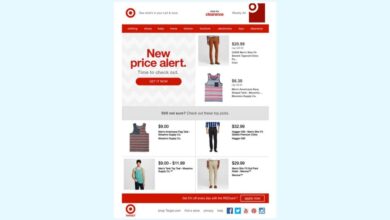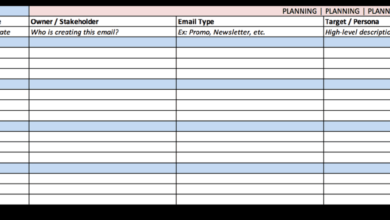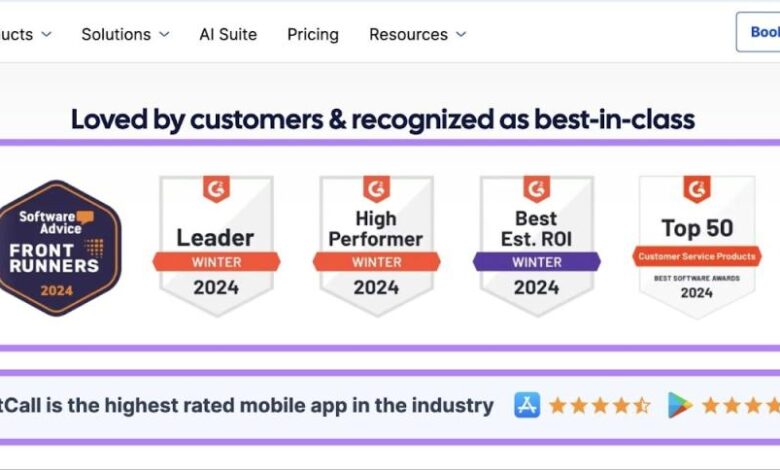
Lower Funnel Marketing Maximizing Conversions
Lower funnel marketing is the crucial final stage of the sales process, where potential customers are primed and ready to buy. It’s about strategically guiding them through the last steps of their journey, focusing on persuasive content and targeted strategies to convert leads into paying customers. From personalized communication to high-quality visuals, this guide delves into the key strategies for success at this critical stage.
This comprehensive look at lower funnel marketing will cover everything from defining the stage to employing effective tools, optimizing campaigns, and analyzing results. We’ll explore proven techniques for identifying and targeting your ideal customers, crafting persuasive content, and measuring campaign performance to maximize your return on investment.
Defining Lower Funnel Marketing
Lower funnel marketing represents the crucial final stages of the customer journey, focusing on driving conversions and maximizing revenue. It’s the point where prospects are highly engaged and ready to take action, making it a critical area for optimization. This stage is characterized by a distinct shift in focus compared to earlier stages, moving from awareness and consideration to purchase.Lower funnel marketing campaigns are strategically designed to convert leads into paying customers.
This is achieved through targeted messaging, compelling calls to action, and a clear path to purchase. The goal isn’t just to get the customer’s attention; it’s to close the deal and build long-term relationships. This stage differs fundamentally from the upper and middle funnels, where the focus is on initial engagement and nurturing potential customers.
Key Characteristics of Lower Funnel Marketing
Lower funnel marketing is distinguished by its emphasis on the customer’s immediate need for a product or service. It’s no longer about broad appeal; instead, it’s about highlighting specific benefits and addressing the customer’s unique requirements. This precision in messaging is essential to convert prospects into customers.
Goals and Objectives
The primary goals of lower funnel marketing campaigns are to drive sales and build customer loyalty. Typical objectives include increasing conversion rates, boosting average order value, and encouraging repeat purchases. These campaigns are designed to maximize the return on investment by focusing on the most qualified leads.
Marketing Materials
Lower funnel marketing relies heavily on persuasive marketing materials designed to encourage immediate action. Examples include product demos, detailed case studies, client testimonials, and clear, concise purchase forms. These materials provide the customer with the necessary information to make a confident purchase decision.
Comparison of Marketing Funnels
| Funnel Stage | Description | Key Focus | Typical Goals |
|---|---|---|---|
| Upper Funnel | Initial awareness and engagement | Creating brand awareness and generating leads | Building brand reputation, driving website traffic, and collecting leads. |
| Middle Funnel | Consideration and evaluation | Educating prospects and building trust | Providing in-depth product information, showcasing benefits, and nurturing leads. |
| Lower Funnel | Conversion and purchase | Driving conversions and maximizing revenue | Increasing conversion rates, boosting average order value, and encouraging repeat purchases. |
Targeting Strategies for Lower Funnel
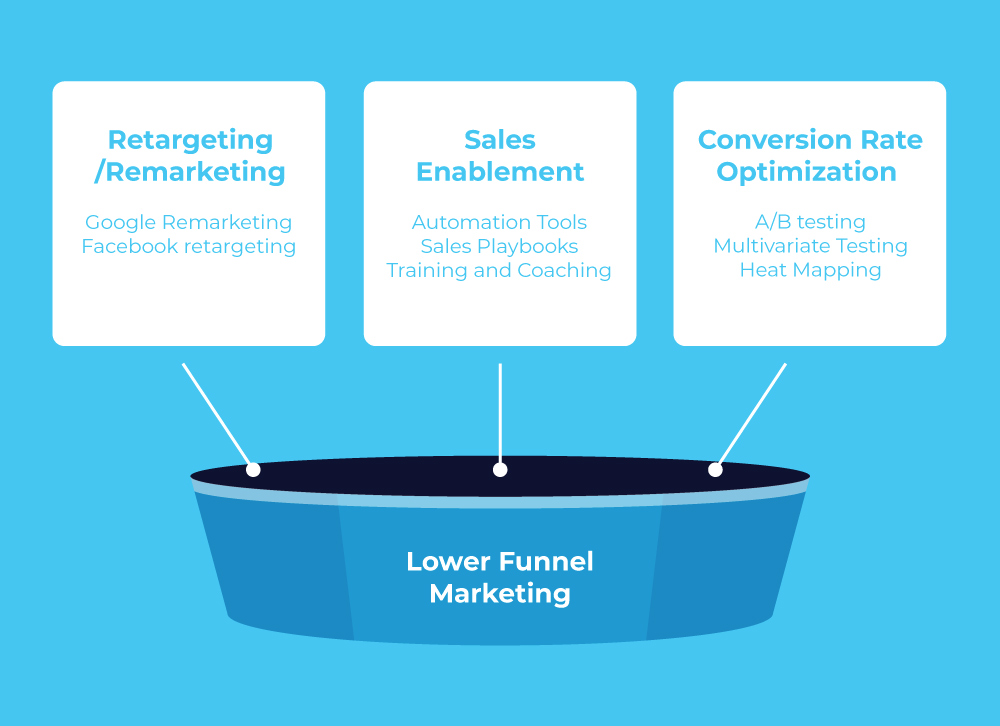
The lower funnel is where the rubber meets the road. After nurturing leads through the top and middle funnels, your marketing efforts now focus on converting those interested into paying customers. Effective targeting at this stage is critical for maximizing conversion rates and return on investment (ROI). This phase requires a deep understanding of your ideal customer and their specific needs and motivations at this point in the buying journey.This involves moving beyond broad demographics and delving into psychographics, behavioral patterns, and the specific pain points that resonate with your ideal customer.
By understanding these nuances, you can craft personalized messaging and experiences that guide them towards a purchase decision.
Identifying Ideal Customers in the Lower Funnel
Identifying your ideal customers in the lower funnel requires a shift in focus from broad audience targeting to highly specific segments. These customers are already engaged and demonstrate a clear interest in your product or service. Therefore, you need to pinpoint their precise needs, pain points, and motivations. This process involves a blend of data analysis, customer feedback, and market research.
Understanding their journey from initial awareness to purchase intent allows you to tailor your message and offer accordingly.
Segmenting Customers Based on Purchase Proximity
Segmenting customers based on their proximity to a purchase is crucial for personalized communication. These segments can be based on actions such as adding items to their cart, visiting product pages repeatedly, or engaging with specific content. This allows you to craft targeted messages that address their current needs and concerns. By tracking these actions, you can identify those who are almost ready to convert.
Personalizing the Customer Journey in the Lower Funnel, Lower funnel marketing
Personalization is paramount in the lower funnel. It’s not enough to simply offer a product; you need to understand the individual’s specific needs and tailor your messaging to address them. Consider using data from previous interactions to understand what aspects of your product or service resonate most with them. This allows for personalized recommendations, targeted offers, and customized experiences.
Examples include product recommendations based on past browsing history, special offers for customers who have viewed a specific product, or personalized follow-up emails.
Lower funnel marketing is all about converting leads into paying customers, right? To do that effectively, you need content that’s laser-focused on the needs of those practically ready to buy. A great example of this is a recent helpful content update on our blog that dives deep into crafting persuasive calls to action and optimizing landing pages for maximum conversion.
helpful content update This kind of focused content is key to achieving your lower funnel goals.
Personalized Communication Techniques
Personalized communication in the lower funnel is critical for converting leads. This involves leveraging various communication channels and techniques to tailor messages to individual needs. For example, sending targeted emails with personalized product recommendations based on browsing history is an effective strategy. Using retargeting ads with tailored messaging is another powerful approach. These personalized approaches can significantly improve conversion rates and customer satisfaction.
Examples of Personalized Communication Techniques
- Abandoned Cart Emails: These emails remind customers of items left in their cart and offer incentives to complete the purchase, such as discounts or free shipping.
- Personalized Product Recommendations: Recommend products based on past browsing history or items in the cart, increasing the likelihood of purchase.
- Targeted Ads: Utilize retargeting ads that show specific products to users who have previously interacted with them on your website.
- Dynamic Content: Show different content based on customer segments or past interactions, such as special offers or tailored FAQs.
Customer Segmentation and Tailored Messaging
This table Artikels different customer segments and tailored messaging strategies for each.
| Customer Segment | Characteristics | Tailored Messaging Strategy |
|---|---|---|
| High-Value Customers | Customers who frequently purchase high-value items or have a high lifetime value. | Exclusive offers, personalized consultations, and premium support. |
| Low-Value Customers | Customers who have not made significant purchases. | Highlight value-added features, bundle deals, or offer limited-time promotions. |
| Abandoned Cart Customers | Customers who have added items to their cart but haven’t completed the purchase. | Incentivize completion with discounts, free shipping, or reminder emails. |
| Returning Customers | Customers who have made previous purchases. | Recommend complementary products, offer loyalty programs, or highlight past purchases. |
Content Strategies for Lower Funnel
Lower funnel marketing focuses on converting potential customers into paying customers. Effective content strategies are crucial in this phase, moving prospects from consideration to purchase. This involves providing persuasive information and addressing specific needs and objections to close the deal.Lower funnel content needs to be highly targeted and tailored to address the specific pain points and desires of your ideal customer at this stage.
It should build on the trust and engagement established in the upper and middle funnels, focusing on providing concrete solutions and answering the customer’s most pressing questions about your product or service.
Content Formats for Lower Funnel Marketing
Content formats in the lower funnel need to be actionable and persuasive. They should move the reader towards a purchase decision. Various formats, such as case studies, product comparisons, and testimonials, help in this process.
- Case Studies: These detailed accounts of how your product or service solved a specific problem for a client are powerful tools. They provide social proof and demonstrate the real-world impact of your offerings.
- Product Comparisons: Directly comparing your product to competitors highlights its unique advantages and addresses potential customer concerns about value.
- Customer Testimonials: Positive feedback from satisfied customers builds trust and credibility, influencing purchasing decisions.
- Product Demos and Tutorials: Showing the product in action or providing detailed instructions on how to use it can be a significant advantage. This format helps reduce the perceived risk and provides confidence in the purchase decision.
- FAQs (Frequently Asked Questions): Addressing common concerns about your product or service through a dedicated FAQ section can be a game-changer, addressing any doubts potential buyers might have.
- Checklists and Guides: Providing actionable checklists or guides that support the buyer’s decision-making process can greatly increase the likelihood of conversion.
- Personalized Recommendations: Offering tailored recommendations based on the customer’s previous interactions can be very effective.
Case Studies, Product Comparisons, and Testimonials
These content formats are essential for building trust and confidence in the lower funnel.
Lower funnel marketing is all about driving those potential customers to the final purchase. A key part of that process is making sure your messaging is crystal clear and concise. Learning how to leverage Twitter effectively for your business is a crucial part of this process. Check out this helpful guide on twitter marketing business guide for actionable tips on crafting tweets that convert.
Ultimately, understanding how to use Twitter strategically will improve your lower funnel marketing performance.
- Case Studies: A well-structured case study should include a clear problem statement, the solution offered by the product or service, the results achieved, and quantifiable metrics. This allows readers to see how similar problems have been solved successfully. For instance, a case study about increasing sales by 20% through a specific marketing strategy would be more compelling than just saying the strategy works.
- Product Comparisons: When comparing products, highlight the unique selling propositions (USPs) of your product and focus on the benefits, not just the features. Avoid being overly critical of competitors; instead, emphasize the value proposition of your product.
- Customer Testimonials: Include a variety of testimonials from different types of customers to show that your product benefits various individuals or companies. Short, impactful quotes are more effective than lengthy testimonials.
High-Quality Visuals
High-quality visuals are critical for engagement and conversions in the lower funnel. They add impact and help communicate complex information effectively.
- Visuals, such as infographics, images, and videos, should be high resolution and relevant to the content. They should enhance the user experience and help to convey the message more clearly.
- High-quality visuals greatly improve the overall presentation of your content, making it more appealing and memorable.
- Visuals are particularly important in product demonstrations and tutorials. Clear, concise images and videos help customers understand the product’s functionality better.
Urgency and Scarcity Tactics
Using urgency and scarcity tactics can effectively motivate buyers to make a purchase decision.
- Urgency and scarcity are psychological triggers that can drive purchasing decisions. These tactics can work best when used strategically, not excessively.
- Creating a sense of urgency through limited-time offers or discounts can motivate quick decisions. Limited-quantity offers can also stimulate immediate action.
- A well-placed call to action can help to reinforce the sense of urgency and encourage immediate action.
Persuasive Language Techniques
Persuasive language in lower funnel content helps influence purchase decisions.
- Active Voice: Using active voice makes the content more direct and engaging.
- Strong Verbs: Strong verbs help to create a sense of action and urgency.
- Benefit-Oriented Language: Focus on the benefits the product or service offers, not just the features.
- Emotional Language: Using emotional language can help create a connection with the reader and influence their decisions.
Content Format Strengths Table
| Content Format | Strengths for Lead Nurturing | Strengths for Conversion |
|---|---|---|
| Case Studies | Demonstrates problem-solving approach | Builds trust and credibility |
| Product Comparisons | Highlights unique value proposition | Reduces decision-making complexity |
| Customer Testimonials | Provides social proof | Enhances credibility and trust |
| Product Demos | Illustrates product functionality | Reduces perceived risk |
Measuring and Optimizing Lower Funnel Campaigns
Lower funnel marketing campaigns are crucial for driving conversions and maximizing return on investment. A deep understanding of campaign performance is paramount for refining strategies and achieving optimal results. This involves meticulously tracking key metrics, analyzing data, and employing strategies like A/B testing to identify areas for improvement and optimization. By focusing on the customer journey, businesses can gain valuable insights to enhance their approach and ultimately drive higher conversion rates.Effective lower funnel campaigns require a data-driven approach.
Analyzing key metrics and employing optimization techniques allows for a thorough understanding of campaign effectiveness and identifies areas needing improvement. A clear understanding of customer journey data provides invaluable insights for refining strategies and improving conversion rates.
Key Performance Indicators (KPIs) for Lower Funnel
Understanding the performance of lower funnel marketing efforts hinges on monitoring specific KPIs. These metrics provide crucial insights into campaign effectiveness, allowing for informed decision-making and optimized strategies. Tracking conversion rates, click-through rates, and other relevant data points is essential for identifying areas for improvement.
- Conversion Rate: The percentage of visitors who complete a desired action, such as making a purchase or filling out a form, is a critical metric. A high conversion rate indicates a successful campaign that resonates with target audiences. For example, if a website receives 1000 visitors and 50 make a purchase, the conversion rate is 5%.
- Click-Through Rate (CTR): This metric measures the percentage of people who click on a specific call-to-action (CTA) or link. A high CTR suggests the CTA is compelling and effectively communicates value to potential customers. A lower CTR might indicate a need to refine the CTA’s language, design, or placement.
- Bounce Rate: The percentage of visitors who leave a website after viewing only one page is called bounce rate. A high bounce rate often suggests that the website is not engaging or relevant to the visitor’s needs. This can indicate issues with the landing page design or the messaging.
- Average Order Value (AOV): This metric measures the average value of each order placed. Increasing AOV can significantly boost revenue and profitability. Strategies for boosting AOV could include offering bundled products or upselling related items.
Analyzing Conversion Rates
Conversion rates are a vital indicator of lower funnel campaign success. Thorough analysis of conversion rates reveals actionable insights into areas needing improvement. Detailed analysis helps identify and rectify bottlenecks in the conversion process. For instance, a low conversion rate on a specific landing page might indicate issues with the page’s design, content, or value proposition.
- Segmentation: Analyzing conversion rates by different customer segments (e.g., demographics, source of traffic) can reveal patterns and tailor messaging to specific groups. This allows for a more personalized and effective approach.
- A/B Testing: A/B testing involves comparing two versions of a webpage or campaign element (e.g., different headlines or calls to action) to determine which performs better. This iterative process of testing and refining can significantly improve conversion rates over time. Testing different CTAs, headlines, or designs on a landing page can identify what resonates best with the target audience.
A/B Testing for Optimization
A/B testing is a crucial component of optimizing lower funnel campaigns. By systematically comparing different variations of elements, businesses can identify what resonates best with their target audience. This iterative approach enables continuous improvement and optimization.
- Testing Different Elements: Test variations in headlines, calls to action, images, and other elements to identify the most effective combinations. For example, test different colors for buttons or different wording for CTAs to see which yields the best response.
- Defining Success Metrics: Clearly define the key metrics for success in A/B testing. This ensures that tests are focused and yield meaningful results. This could include conversions, CTR, or other relevant metrics.
Customer Journey Analysis for Refinement
Understanding the customer journey is crucial for optimizing lower funnel campaigns. Analyzing the steps customers take before making a purchase provides insights into pain points and areas for improvement. This data-driven approach allows for a more personalized and effective approach to marketing.
- Identifying Pain Points: Analyze where customers drop off in the sales funnel to pinpoint areas where the experience needs improvement. For example, if customers are abandoning their shopping carts, the issue might be a complex checkout process or lack of clear shipping options.
- Improving the User Experience: Use customer journey data to identify pain points and improve the user experience at each stage of the funnel. This could involve simplifying the checkout process, offering clear shipping options, or providing helpful product information.
Metric Comparison Table
| Metric | Description | Significance in Lower Funnel |
|---|---|---|
| Conversion Rate | Percentage of visitors completing a desired action | Crucial for evaluating campaign effectiveness and identifying areas needing improvement. |
| Click-Through Rate (CTR) | Percentage of clicks on a specific link or call to action | Indicates the effectiveness of calls to action and the clarity of messaging. |
| Bounce Rate | Percentage of visitors leaving after viewing only one page | Highlights potential issues with landing page engagement and relevance. |
| Average Order Value (AOV) | Average value of each order placed | Shows potential for revenue enhancement through strategies like upselling and bundling. |
Tools and Technologies for Lower Funnel Marketing
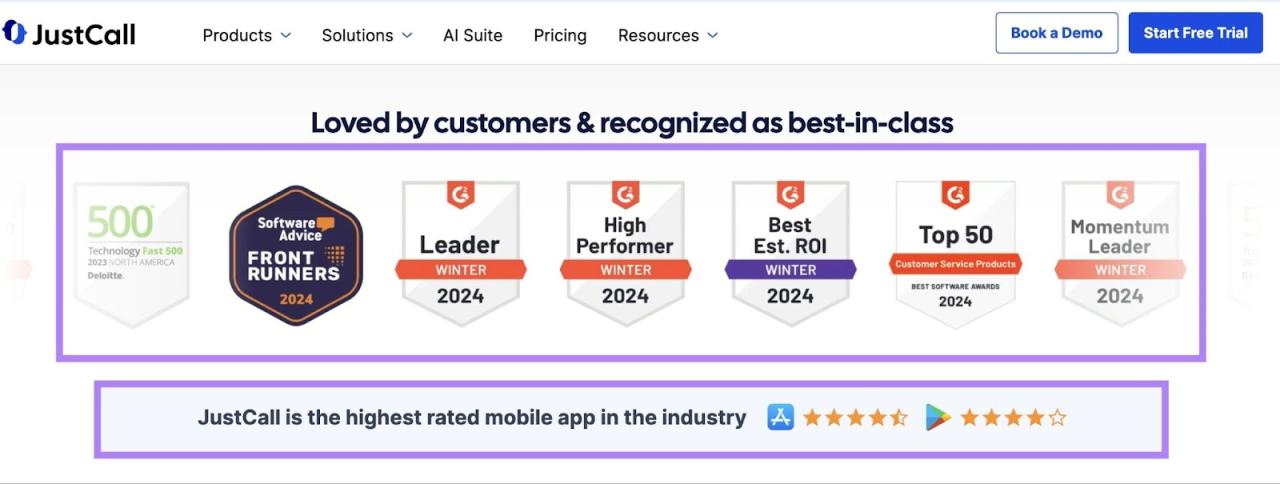
Lower funnel marketing focuses on converting leads into paying customers. Effective tools are crucial for automating and optimizing these final stages. The right technologies streamline processes, personalize interactions, and ultimately boost conversion rates. Choosing the right tools is vital to achieving these goals.
Popular Automation Tools for Lower Funnel Tasks
Automation is key to efficient lower funnel marketing. Tools streamline lead nurturing, personalized email campaigns, and crucial customer relationship management. Effective automation tools allow businesses to scale their efforts while maintaining high levels of customer engagement.
Email Marketing Solutions
Email marketing remains a powerful tool in the lower funnel. It allows for direct communication with potential customers, fostering engagement and driving conversions. These tools are critical for delivering personalized content, building relationships, and closing deals. Examples include:
- Mailchimp: A popular choice for its user-friendly interface and extensive features, including email templates, automation tools, and analytics.
- ActiveCampaign: Known for its robust automation capabilities, ActiveCampaign allows for sophisticated lead nurturing and personalized email sequences.
- SendGrid: A powerful API-driven platform that offers scalability and flexibility for advanced email marketing strategies.
Lead Nurturing Software
Lead nurturing helps potential customers move through the sales funnel by providing valuable content. Effective nurturing keeps customers engaged until they’re ready to convert. Sophisticated tools allow for targeted content delivery based on customer behavior and preferences. Examples include:
- HubSpot: Provides comprehensive lead nurturing capabilities, including email automation, lead scoring, and personalized content delivery.
- Marketo: Known for its sophisticated automation and personalization features, Marketo empowers businesses to create highly targeted lead nurturing campaigns.
- Drip: A powerful tool specializing in email marketing and automation, perfect for creating automated workflows based on user interactions.
Customer Relationship Management (CRM) Software
CRM systems centralize customer data, providing a 360-degree view of customer interactions. This data is crucial for personalizing interactions and improving customer satisfaction. Examples include:
- Salesforce: A comprehensive CRM platform that offers various functionalities, including sales automation, customer service management, and marketing automation.
- Zoho CRM: A cloud-based CRM platform with a user-friendly interface, suitable for businesses of all sizes, offering various features for managing sales, marketing, and customer service.
- Microsoft Dynamics 365: A powerful suite of applications, including CRM, that integrate seamlessly with other Microsoft products, offering a comprehensive solution for businesses.
Marketing Automation Platforms
Marketing automation platforms (MAPs) integrate various tools, enabling streamlined processes. They orchestrate marketing efforts, automate workflows, and enhance personalized customer experiences. MAPs provide a central hub for managing and tracking campaigns across different channels. Examples include:
- HubSpot Marketing Hub: Provides a complete suite of tools for managing all marketing aspects, from email to social media.
- ActiveCampaign: A robust marketing automation platform that allows for creating personalized customer journeys.
- Marketo: A comprehensive MAP known for its sophisticated features and scalability, ideal for large enterprises.
Tool Integration for Seamless Customer Journeys
Integrating various tools creates a seamless customer experience. Data exchange between platforms ensures a unified view of the customer, enabling personalized interactions. This unified approach creates a positive brand experience and increases customer loyalty.
Choosing the Right Tools for Your Business Needs
The best tools depend on your specific business needs and resources. Consider factors like budget, scale, and complexity of your marketing operations. Thorough research and careful evaluation are essential for making informed decisions.
Comparison of Marketing Automation Platforms
| Feature | HubSpot | ActiveCampaign | Marketo |
|---|---|---|---|
| Ease of Use | High | High | Medium |
| Scalability | High | High | Very High |
| Pricing | Affordable | Affordable to Enterprise | Enterprise |
| Features | Comprehensive | Robust Automation | Sophisticated Personalization |
Case Studies of Successful Lower Funnel Campaigns
Lower funnel marketing is crucial for driving conversions and maximizing return on investment. Understanding how successful campaigns are structured and executed provides valuable insights for marketers seeking to optimize their own strategies. Analyzing real-world examples of successful lower funnel campaigns reveals key strategies, tactics, and measurable results.Effective lower funnel campaigns go beyond simple advertising. They engage potential customers at a stage where they are actively considering a purchase, providing them with compelling reasons to choose a particular product or service.
This often involves personalized content, targeted messaging, and a clear call to action. By focusing on these factors, businesses can significantly improve their chances of converting leads into paying customers.
Real-World Examples of Effective Campaigns
Lower funnel marketing campaigns can be highly effective when tailored to the specific needs and desires of the target audience. These campaigns are designed to nurture leads through personalized content and targeted messaging, guiding them toward a conversion.
Strategies and Tactics
Successful lower funnel campaigns employ a variety of strategies and tactics to engage customers and drive conversions. A key element is understanding the customer journey and tailoring the messaging to specific stages of that journey.
Lower funnel marketing is all about converting those leads into paying customers. It’s about nurturing those prospects who are already interested in your products or services, and that’s where strategies like “heat up your b2b leads with crm based digital marketing” heat up your b2b leads with crm based digital marketing become crucial. By using CRM data to personalize your approach and tailor your messaging, you can move those leads down the funnel and boost sales.
Ultimately, strong lower funnel marketing ensures you’re closing deals effectively and maximizing your ROI.
- Personalized Recommendations: Amazon, for instance, uses extensive data to recommend products based on past purchases and browsing history. This personalized approach significantly increases conversion rates by showcasing items that align with customer preferences.
- Targeted Email Marketing: Companies like Sephora leverage email marketing to segment their customers based on their purchase history and preferences. This allows for targeted messaging that focuses on products or services that the customer is most likely to be interested in, leading to higher engagement and conversion rates.
- Limited-Time Offers and Discounts: Many retailers utilize limited-time offers and discounts to create a sense of urgency and encourage immediate purchases. This tactic can significantly increase conversion rates, especially for products with a high price point or complex features.
Results and Impact
Analyzing the results of lower funnel campaigns provides insights into their effectiveness and impact. Positive outcomes often include increased conversion rates, higher customer lifetime value, and stronger brand loyalty.
- Increased Conversion Rates: A company selling software solutions, for example, saw a 25% increase in conversion rates after implementing a targeted email campaign that offered personalized recommendations and discounts.
- Higher Customer Lifetime Value: A fashion e-commerce site noticed a 15% increase in customer lifetime value after implementing a personalized recommendation system that showcased products based on past purchases and browsing history.
- Stronger Brand Loyalty: A coffee shop that implemented a loyalty program, providing exclusive offers and discounts to frequent customers, saw a 20% increase in repeat business.
Impact on Brand Awareness and Customer Loyalty
Successful lower funnel campaigns often lead to positive brand perception and increased customer loyalty. By providing personalized experiences and value, these campaigns create a stronger connection with the customer, fostering loyalty and advocacy.
Table of Case Studies
| Case Study | Strategies | Key Results |
|---|---|---|
| Amazon Personalized Recommendations | Utilizing extensive customer data to recommend products | Increased conversion rates, higher customer satisfaction |
| Sephora Targeted Email Marketing | Segmenting customers based on purchase history and preferences | Increased engagement, higher conversion rates |
| Retailer Limited-Time Offers | Creating a sense of urgency with discounts | Increased conversion rates, higher sales volume |
Future Trends in Lower Funnel Marketing
Lower funnel marketing is no longer about simply pushing a sale. It’s about understanding the customer journey deeply, anticipating needs, and fostering lasting relationships. The future of this critical stage hinges on emerging technologies and evolving consumer expectations. This means marketers must adapt strategies to meet these new demands and remain competitive.
Personalization at Scale
Personalization is not a new concept, but the ability to personalize at scale is transforming the customer experience. Advanced data analytics and machine learning algorithms allow businesses to understand individual customer needs and preferences with unprecedented precision. This translates to tailored product recommendations, targeted messaging, and customized offers. By leveraging data effectively, companies can move beyond generic messaging and create highly relevant interactions that resonate with individual customers.
For example, a clothing retailer can recommend specific styles based on past purchases and browsing history, driving higher conversion rates and customer loyalty.
The Rise of AI in Marketing Automation
AI is rapidly changing how businesses manage and automate their marketing efforts, especially in the lower funnel. AI-powered chatbots and virtual assistants can provide instant support, answer customer questions, and guide them through the purchase process. This proactive engagement fosters trust and efficiency, ultimately leading to higher conversion rates. For instance, a travel agency could use AI to personalize itineraries based on customer preferences, proactively address concerns, and provide real-time support throughout the booking process.
Voice Search Optimization
The rise of voice search is dramatically changing how customers interact with brands. This shift necessitates a change in content strategy to cater to voice search queries. Businesses need to focus on providing concise, conversational answers to common questions and addressing customer needs in a conversational tone. For example, a home appliance company might optimize its website and marketing materials for voice search queries like “how to install a dishwasher” or “best dishwasher for small kitchens,” leading to more organic traffic and conversions.
The Transformative Power of Customer Experience
These trends are not merely technological advancements; they’re fundamental shifts in how customers expect to interact with brands. By embracing personalization, AI, and voice search, companies can create more seamless, engaging, and supportive experiences. This, in turn, strengthens customer loyalty and advocacy, fostering long-term relationships and generating positive word-of-mouth. For example, a financial institution can use AI-powered chatbots to provide instant answers to customer questions about accounts, products, and services, reducing wait times and improving customer satisfaction.
Strategies to Stay Ahead of the Curve
Staying ahead of the curve in lower funnel marketing requires a proactive approach. Businesses must invest in data analytics, machine learning, and AI technologies to leverage the power of personalization and automation. Furthermore, they need to adapt their content strategy to align with the evolving needs of voice search. By continually evaluating and adapting to emerging trends, businesses can ensure their marketing efforts remain relevant and effective in the future.
Future Trends and Implications
| Future Trend | Implications for Lower Funnel Marketing |
|---|---|
| Personalization at Scale | Increased conversion rates, higher customer lifetime value, enhanced customer satisfaction. |
| AI in Marketing Automation | Improved customer support, faster response times, reduced operational costs, enhanced efficiency. |
| Voice Search Optimization | Improved organic search visibility, increased traffic from voice searches, more natural and conversational interactions. |
Final Thoughts
In conclusion, mastering lower funnel marketing is essential for driving conversions and boosting revenue. By focusing on personalization, persuasive content, and effective tools, businesses can transform potential customers into loyal customers. This guide provides a framework for understanding and implementing these strategies, helping you to optimize your campaigns and achieve significant results. Remember that consistent analysis and adaptation are key to staying ahead of the curve in this ever-evolving landscape.
